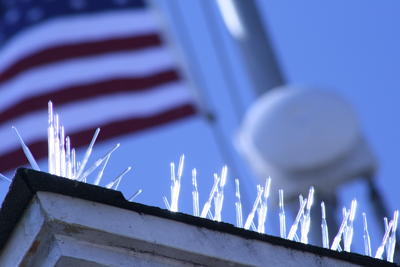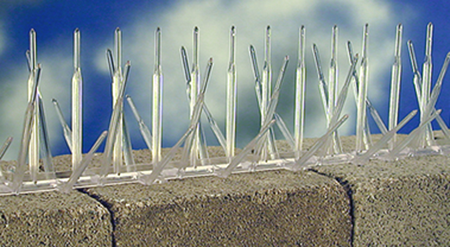 Your food handling facility can’t afford to have a pest bird problem. Without effective bird repellents or bird deterrents, bird droppings can contaminate stored food—even heavily packaged food. The most common pest birds drawn to food handing facilities are pigeons, sparrows, starlings, seagulls, crows and swallows. Pigeons, sparrows and starlings create most of the pest bird problems at food establishments.
The acid in bird droppings can eat into cardboard, plastic wrap, even metal cans. Bird droppings can also carry any of 60 known diseases, including encephalitis, Newcastle disease, histoplasmosis, cryptocococcosis, toxoplasmosis, pseudo-tuberculosis, pigeon coccidiosis and salmonellosis.
Your food handling facility can’t afford to have a pest bird problem. Without effective bird repellents or bird deterrents, bird droppings can contaminate stored food—even heavily packaged food. The most common pest birds drawn to food handing facilities are pigeons, sparrows, starlings, seagulls, crows and swallows. Pigeons, sparrows and starlings create most of the pest bird problems at food establishments.
The acid in bird droppings can eat into cardboard, plastic wrap, even metal cans. Bird droppings can also carry any of 60 known diseases, including encephalitis, Newcastle disease, histoplasmosis, cryptocococcosis, toxoplasmosis, pseudo-tuberculosis, pigeon coccidiosis and salmonellosis.
Pest Birds Have Adapted
Bird pests have successfully acclimated to man-made environments and are very resourceful in finding ways to get at food. The presence of birds in food facilities should be treated with the same level of concern and urgency as rodent infestations. When checking for the presence of birds at your food facility, inspect the roof for nesting pigeons. They can often be found nesting, roosting and loitering around heating, ventilation and AC units. Bird droppings can enter AC systems, and disease-carrying contaminants can be easily distributed throughout your facility.
Plastic Bird Spikes Will Deter Pest Birds
More economical than steel spikes, plastic (polycarbonate) bird spikes are the anti-perching, anti-roosting bird deterrent that will prevent larger birds from gathering around your facility. Approved by a number of humane groups—including the U.S. Humane Society—plastic spikes are blunted at the tips so they won’t harm birds or installers. The plastic bird spikes offered by Bird-B-Gone come in two-foot sections and three different widths—3-, 5- and 7-inch—to provide wider and wider areas of bird deterrence. The base of each spiked strip is just 1.5 inches wide, so it can be installed on narrow ledges, windowsills, beams and pipes. A built-in glue tough and pre-drilled mounting holes simplify installation using common glues, screws or tie downs. The spiked strip’s flexible base easily “follows” curved surfaces, such pipes and rooftop structures.
The Bird Spike That’s Built to Last
Bird-B-Gone plastic bird spikes are GSA approved and made of unbreakable UV-protected polycarbonate plastic to deter pest birds for years in harsh outdoor weather. The spikes are non-conductive and won’t interfere with your rooftop antennas or transmission equipment. Each bird spike is manufactured in the USA and comes with a 5-year guarantee.
Final Thoughts on Deterring Pest Birds
To help eliminate your pest bird problem, there are some steps you can take to augment plastic bird spikes. For one, don’t allow employees to feed birds around your food facilities. You should also minimize any unnecessary use of water outside your facility. Repair any leaking faucets and adjust landscape irrigation systems to prevent puddles. Fix or repair low spots in landscapes and hardscapes that could catch and retain water. Repair gutters and downspouts to prevent water pooling and ensure drainage. Remove any unwanted food, food debris, food wrappers and food containers from around your facility.



